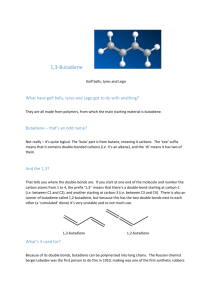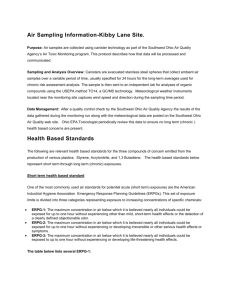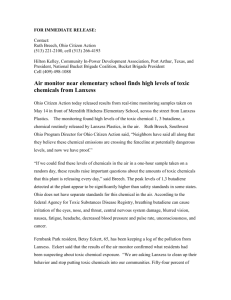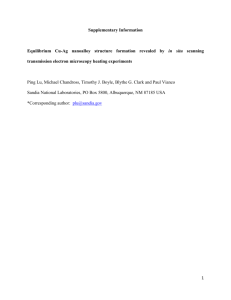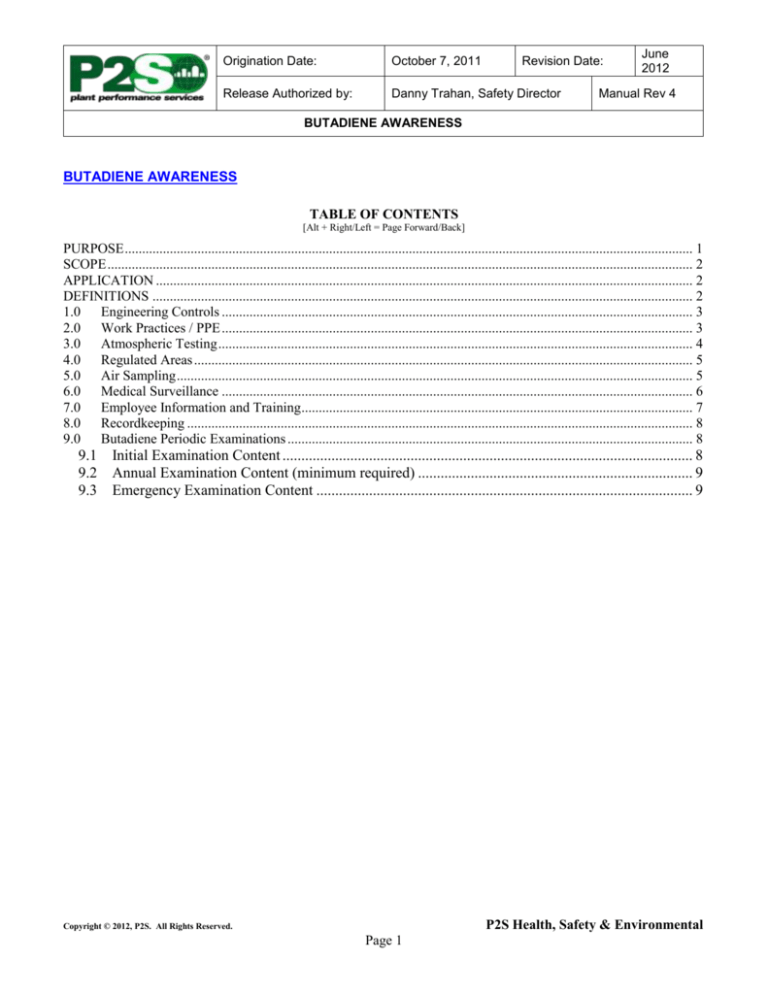
Origination Date:
October 7, 2011
Revision Date:
Release Authorized by:
Danny Trahan, Safety Director
June
2012
Manual Rev 4
BUTADIENE AWARENESS
BUTADIENE AWARENESS
TABLE OF CONTENTS
[Alt + Right/Left = Page Forward/Back]
PURPOSE .................................................................................................................................................................... 1
SCOPE ......................................................................................................................................................................... 2
APPLICATION ........................................................................................................................................................... 2
DEFINITIONS ............................................................................................................................................................ 2
1.0 Engineering Controls ........................................................................................................................................ 3
2.0 Work Practices / PPE ........................................................................................................................................ 3
3.0 Atmospheric Testing ......................................................................................................................................... 4
4.0 Regulated Areas ................................................................................................................................................ 5
5.0 Air Sampling ..................................................................................................................................................... 5
6.0 Medical Surveillance ........................................................................................................................................ 6
7.0 Employee Information and Training ................................................................................................................. 7
8.0 Recordkeeping .................................................................................................................................................. 8
9.0 Butadiene Periodic Examinations ..................................................................................................................... 8
9.1
9.2
9.3
Initial Examination Content ............................................................................................................. 8
Annual Examination Content (minimum required) ......................................................................... 9
Emergency Examination Content .................................................................................................... 9
P2S Health, Safety & Environmental
Copyright © 2012, P2S. All Rights Reserved.
Page 1
Origination Date:
October 7, 2011
Revision Date:
Release Authorized by:
Danny Trahan, Safety Director
June
2012
Manual Rev 4
BUTADIENE AWARENESS
PURPOSE
This program has been developed to standardize work practices, set forth engineering practice, industrial hygiene
and medical standards involving the potential exposure to 1, 3-butadiene (CAS # 106-99-0) containing materials.
This program complies with 29 CFR
1910.1200 - Hazard Communication, 29 CFR 1910.1051 - 1, 3-Butadiene
and in accordance with sound industrial hygiene principles.
SCOPE
All P2S employees, Sub contractors and visitors whose work may involve exposure to 1, 3butadiene (1, 3-butadiene
> 0.1 percent) could be subject to possible exposure.
Butadiene may be present at refineries and petrochemical plants. Butadiene is used in the production of styrenebutadiene rubber and polybutadiene rubber for the tire industry. Other uses include copolymer latexes for carpet
backing and paper coating, as well as resins and polymers for pipes and automobile and appliance parts. It is also
used as an intermediate in the production of such chemicals as fungicides.
Butadiene may also be found in some process stream lines and equipment within many of our client Petro chemical
facilities.
APPLICATION
This practice applies to work activities and employees under the control of P2S and its contractors.
DEFINITIONS
Action Level means an airborne concentration of 1, 3-butadiene of 0.5 ppm calculated as an 8-hour time-weighted
average.
Butadiene Characteristics: Butadiene is a flammable, colorless gas with a mile, aromatic odor at room temperature
and pressure. Butadiene may also exist as a cryogenic liquid. Butadiene is insoluble in water, stale and reacts with
oxidizers.
1, 3-butadiene: refers to liquid or gaseous 1, 3-butadiene. It includes 1, 3-butadiene contained in liquid mixtures and
the 1, 3-butadiene vapors released by these liquids.
Employee exposure: means exposure to airborne 1, 3-butadiene, which would occur if the employee were not using
respiratory protective equipment.
Permissible Exposure Limit (PEL): refers to the concentrations to which an employee may be exposed and not
experience any adverse health effects.
Time-Weighted Average (TWA): refers to a concentration of 1, 3-butadiene in excess of one part of 1, 3butadiene per million parts of air (1 ppm) as an 8-hour TWA.
Short-Term Exposure Limit (STEL): refers to an airborne concentration of 1, 3-butadiene in excess of five (5) ppm
as averaged over any 15 minute period.
Regulated Area: refers to any area where airborne concentrations of 1,3-butadiene exceed or can reasonably be
expected to exceed the permissible exposure limits, either the 8-hour TWA of 1 ppm or the STEL of 5 ppm for 15
minutes
P2S Health, Safety & Environmental
Copyright © 2012, P2S. All Rights Reserved.
Page 2
Origination Date:
October 7, 2011
Revision Date:
Release Authorized by:
Danny Trahan, Safety Director
June
2012
Manual Rev 4
BUTADIENE AWARENESS
Engineering Controls
Breathing very high levels of butadiene for a short time can cause central nervous system effects, blurred vision,
nausea, fatigue, headache, decreased blood pressure and pulse rate as well as unconsciousness. There are no
recorded cases of accidental exposures at high levels that have caused death in humans, however this can occur.
Breathing lower levels of butadiene may cause irritation of the eyes, nose and throat. Skin contact with liquefied
butadiene can cause irritation and frostbite. Butadiene is a carcinogen.
The following task(s) involve potential exposures at or above the action level for 1.3-butadiene:
Welders, Boilermakers and Pipefitters working around handling or sampling of
catalyst in Butadiene areas. These workers are required to don appropriate PPE for
protection against butadiene.
Opening flanges, exchangers, piping systems or performing first line breaks on
equipment. (Appropriate PPE and respiratory protection is required.)
Entering confined spaces or other regulated where the concentration of butadiene is
known to be present.
The following engineering controls may be used:
A leak prevention, detection, and repair program (Environmental Dept).
The use of pump exposure control technology such as, but not limited to, mechanical
double sealed or seal-less pumps.
Closed-loop quality control sampling systems. Failure to properly use these systems
may result in personnel exposure. Any malfunction of these systems should be
reported immediately to the Operations Shift Supervisor.
When engineering controls are deemed infeasible or do not reduce the exposure below
the action level, respiratory protection and standardized work practices shall be
implemented.
Fire extinguishers should be readily available in areas where butadiene is present of where butadiene may be
released.
1.0
Work Practices / PPE
Eye and skin protection should be worn where exposures to liquid butadiene may occur. Respirators may be
required where exposures are above the permissible exposure limit, and emergency respirators may be required
where releases could occur. Contact lenses should not be worn when working with this chemical.
Equipment preparation for maintenance shall be the responsibility of the Operations Department.
Equipment shall be rendered as free as possible of 1, 3-butadiene containing
maintenance.
material prior to opening for
Processes and equipment containing 1, 3-butadiene shall not be depressured, vented, or drained to atmosphere. Use
of the Flare Header shall be considered in each circumstance prior to depressuring, venting, or draining.
For those circumstances when 1, 3-butadiene containing equipment must be
depressured to atmosphere the following
considerations must be taken:
opened , drained, vented, or
P2S Health, Safety & Environmental
Copyright © 2012, P2S. All Rights Reserved.
Page 3
Origination Date:
October 7, 2011
Revision Date:
Release Authorized by:
Danny Trahan, Safety Director
June
2012
Manual Rev 4
BUTADIENE AWARENESS
Affected personnel must wear appropriate respiratory protection and protective
clothing.
Operations personnel shall be responsible for establishing a Regulated Area as
outlined in Section 4.0.
Near by personnel shall be evacuated from the affected area, and Hot Work suspended
in the affected work areas.
All 1, 3-butadiene-containing materials shall be contained and residual immediately
removed form the area.
Failure to follow the above listed practices may result in violation of State and Federal Safety and Environmental
regulations. Willful violation of this safety procedure by any Refinery employee or contractor will result in
disciplinary action.
Any respiratory protection will comply with 29 CFR 1910.134. If a cartridge respirator is used, a label must be
attached to each filter element indicating the date and time the filter was first installed on the respirator. Organic
Vapor or Butadiene cartridges must be used on the cartridge respirators.
Respiratory protection for 1, 3-butadiene-containing materials shall be selected according to atmospheric testing
and in accordance with the following table:
Atmospheric
Concentration
0.5 - 10 ppm
10 - 50 ppm
50 -1000 ppm
Unknown
Respiratory Protection
Half-mask chemical cartridge (cartridges changed
every 3 hours) or supplied air
Full-face chemical cartridge (cartridges changed
every (1) hour) or supplied air
Full-face supplied air pressure demand mode or
other positive pressure
Full-face supplied air in pressure demand or other
positive pressure mode with escape pack
For line breaking operations or those tasks involving 1,3-butadiene containing liquids in which a splash potential
exists, a chemical protective suit including eye/facial protection, shall be utilized in conjunction with respiratory
protection.
Disposable Kappler “CPF III” chemical protective suit for 1, 3- butadiene containing materials should be requested
for any P2S employees that may be working around Butadiene.
If contaminated, they should be discarded immediately per customer procedures.
2.0
Atmospheric Testing
P2S will be responsible for ensuring that Atmospheric Testing for 1, 3-butadiene has been conducted in areas where
exposure is possible
Atmospheric testing for 1, 3-butadiene may be accomplished through the use of colorimetric detection tubes.
Only qualified personnel shall perform line break atmospheric testing for 1, 3- butadiene by use of colorimetric
detection tubes (i.e., Draeger tubes).
P2S Health, Safety & Environmental
Copyright © 2012, P2S. All Rights Reserved.
Page 4
Origination Date:
October 7, 2011
Revision Date:
Release Authorized by:
Danny Trahan, Safety Director
June
2012
Manual Rev 4
BUTADIENE AWARENESS
3.0
Regulated Areas
P2S and all P2S employees should be aware of the owner’s contingency plan provisions. Employees must be
informed where butadiene is used in the host facility and made aware of additional plant safety rules.
Exposure Limits
Organization
OSHA
1 ppm Permissible Exposure Limit (PEL)
OSHA
5 ppm for 15 minute(s) Short-Term Exposure Limit (STEL)
NIOSH
1 ppm Recommended Exposure Limit (REL) for 8-hour Time
Weighted Average (TWA)
Regulated Areas shall be established whenever job tasks (line breaking, depressurizing, etc.) result in or can
reasonably be expected to create airborne
concentrations above either the TWA of 1.0 ppm or the STEL of
5.0 ppm.
Regulated Areas shall be defined by use of Danger Tape (color coded red/black or worded DANGER DO NOT
ENTER) and appropriate signs.
Signs shall be worded and consistent with the following format:
DANGER
REGULATED AREA
1, 3-BUTADIENE
AUTHORIZED PERSONNEL ONLY
RESPIRATORY PROTECTION REQUIRED
NO SMOKING
The size and boundaries of the Regulated Area shall be determined by atmospheric testing, wind conditions and
prior experiences.
Smoking is prohibited in areas where butadiene is present or where butadiene may be released and will not be
authorized in or near REGULATED AREAS
4.0
Air Sampling
Participation in 1, 3-butadiene air sampling is based on federal regulations, sound Industrial Hygiene practice and
prior air sampling data. All exposure monitoring will comply with 29 CFR1910.1051 (d).
1, 3-butadiene air sampling for all other field personnel is done on an as needed basis.
All 1, 3-butadiene air samples shall be collected and analyzed in accordance with NIOSH Method 1024 - 1,3Butadiene.
All 1, 3-butadiene air samples, 8 hour Time-Weighted Average, Short Term Exposure Limit, taken for personnel
exposure measurement shall be collected by active or passive Sampling.
For short-term exposure passive sampling, all data that exceeds the action limit must be confirmed via active
sampling or with a direct reading instrument.
P2S Health, Safety & Environmental
Copyright © 2012, P2S. All Rights Reserved.
Page 5
Origination Date:
October 7, 2011
Revision Date:
Release Authorized by:
Danny Trahan, Safety Director
June
2012
Manual Rev 4
BUTADIENE AWARENESS
Air sampling results shall be verbally provided to affected employees within 15 working days of receipt of
laboratory analysis for either routine monitoring or monitoring from overexposure.
Employees or their representative have the opportunity to observe any monitoring of employee exposure to 1, 3butadiene.
5.0
Medical Surveillance
Medical Surveillance Program shall be administered by a PRE DETERMINED Occupational Medical Facility. If
needed, a medical screening and surveillance program will be provided for any affected P2S employees.
Employees within the Butadiene Regulated areas are to be included in this medical surveillance program
1, 3-butadiene (BD) is a probable human carcinogen believed to increase the risk of cancers of the
lymphohematopoietic system (leukemia, non-Hodgkin’s lymphoma and anemia), as well as potential reproductive
toxicity.
All examination and test fees will be paid for by P2S. If additional testing is negative, approval from the workers’
compensation or medical service provider will be required. Testing or follow-up procedures outside the range of
the Butadiene exposure examination will be the responsibility of the employee.
All examinations are to be performed by or under the supervision of a licensed physician and all laboratory tests are
to be conducted by an accredited laboratory.
Any employee using a respirator must comply with all of the requirements identified in the P2S Respiratory
Protection Policy.
Medical screening will be provided as follows:
An initial physical examination if twelve months or more have elapsed since the last
physical examination conducted as a part of a medical screening program for BD
exposure.
Before assuming duties by employee in a job with a known potential for BD exposure.
At least every three years after the initial physical examination (all employees have
annual medical exams).
At the discretion of the physician or other health professional reviewing the annual
health questionnaire/ history and CBC.
At the time of employee reassignment to an area where exposure to BD is below the
action level, if the employee’s past exposure history does not meet the criteria for
continued coverage in the screening and surveillance program and if twelve months or
more have elapsed since the last physical examination.
At termination of employment if twelve months or more have elapsed since the last
physical examination.
Following an emergency situation, as quickly as possible, but no later than forty-eight
hours past exposure.
Medical Screening may include, an Initial Examination to be done before the assuming duties in a job with BD
exposure, Annual Examinations, and an Emergency Examination must be done when an employee is exposed to
BD in an emergency situation within 48 hours.
When the results of the medical screening indicate abnormalities of the hematopoietic or reticuloendothelial
systems for which a non-occupational cause is not readily apparent, the examining physician may refer the
P2S Health, Safety & Environmental
Copyright © 2012, P2S. All Rights Reserved.
Page 6
Origination Date:
October 7, 2011
Revision Date:
Release Authorized by:
Danny Trahan, Safety Director
June
2012
Manual Rev 4
BUTADIENE AWARENESS
employee to an appropriate specialist for further evaluation and will make available the results of the medical
screening to the specialist after consultation with the Medical Director. The specialist will determine the
appropriate content for the medical evaluation.
P2S will provide the following information to the physician or other licensed health care professional.
A copy of the standard.
A description of the affected employee’s duties as they relate to the BD exposure.
The employee’s actual or representative BD exposure level during employment
tenure, including documented exposures incurred in an emergency situation.
A description of pertinent personal protective equipment used or to be used.
Information, (when available,) from previous employment related medical evaluations
of the affected employee
For each medical evaluation the physician must provide a written opinion to the employer and the employee within
fifteen business days of the evaluation, which will be limited to the following:
The occupationally pertinent results of the medical evaluation.
A medical opinion concerning whether the employee has any detected medical
conditions which would place the employee’s health at risk of material impairment
from exposure to BD.
Any recommended limitations upon the employee’s exposure to BD.
A statement that the employee has been informed of the results of the medical
evaluation and any medical condition resulting from BD exposure that may require
further explanation of treatment.
When the results of the medical screening indicate abnormalities of the hematopoietic of reticuloendothelial
systems for which a non-occupational cause is not readily apparent, the examining physician may refer the
employee to an appropriate specialist for future evaluation after consultation with the Refinery’s workers’
compensation medical services provider. Results of the medical screening should be made available to the
specialist and the specialist will determine the appropriate content for the medical evaluation.
P2S will maintain an accurate record for each employee subject to medical screening and surveillance. The record
will include the following:
6.0
The name and social security number of the employee.
Physician’s written opinions.
A copy of the information provided to the physician.
Medical screening and surveillance records will be maintained for each employee for
the duration of employment plus thirty years.
When the employer ceases to do business, the employer will transfer records to the
successor employer.
Employee Information and Training
Training should be provided on the health hazards and any use or handling requirements for butadiene at time of
initial assignment and annually.
P2S Health, Safety & Environmental
Copyright © 2012, P2S. All Rights Reserved.
Page 7
Origination Date:
October 7, 2011
Revision Date:
Release Authorized by:
Danny Trahan, Safety Director
June
2012
Manual Rev 4
BUTADIENE AWARENESS
Employees will be made aware of the hazards of 1,3-butadiene during initial training, when assigned to a unit
where 1,3-butadiene could be present, or when performing non-routine jobs in which they may become exposed to
1,3-butadiene.
Training will comply with both 29 CFR 1910.1200 and 29 CFR 1910.1051 (l).
Employees who may be exposed to levels of 1, 3-butadiene above the action level or STEL, will have records
maintained of their training along with a record of the contents of the training to ensure the employees are
participating in the
training. This training will be conducted on an annual basis as a minimum. Employees
will have to demonstrate they have understood the training.
Employees may access the butadiene standard by requesting a copy from the P2S Corporate Safety Department.
Employees will be instructed of all evacuation routes and assembly areas at the on site orientation
7.0
Recordkeeping
Air monitoring and medical records shall be retained in compliance with 29 CFR 1910.1020 and 29 CFR
1910.1051 (m).
8.0
Butadiene Periodic Examinations
8.1
Initial Examination Content
Health History (respiratory questionnaire): obtain information related to hematopoietic and reticuloendothelial
systems and reproductive difficulties.
CBC with differential and platelet count, including:
Leukocyte count with differential
Quantitative thrombocyte count
Hematocrit
Hemoglobin
Erythrocyte count
Erythrocyte indices
MCV
MCH
MCHC
Physical Examination should be directed at identification of signs of lymphohematopoietic disorders, including
lymph node enlargement, splenomegaly, hepatomegaly, and skin.
Appropriate additional tests will be performed as necessary in the opinion of the examining physician, as a result of
alterations in the components of the blood or other signs which may be related to butadiene exposure. These tests
may include:
Blood Chemistry including:
Glucose
Sodium
Potassium
P2S Health, Safety & Environmental
Copyright © 2012, P2S. All Rights Reserved.
Page 8
Origination Date:
October 7, 2011
Revision Date:
Release Authorized by:
Danny Trahan, Safety Director
June
2012
Manual Rev 4
BUTADIENE AWARENESS
8.2
Annual Examination Content (minimum required)
8.3
Chloride
Blood Urea Nitrogen
Creatinine
BUN/Creatine Ration
Uric Acid
Phosphate
Calcium
Cholesterol
High Density Lipoprotein (HDL)
Triglycerides
Albumin
Globulin
Alb/Glob Ratio
Total Protein
Total Bilirubin
Alkaline Phosphatase
Transaminase, SGO (SGOT)
Transaminase, SPP (SGPT)
L.D.H.
Urinalysis with microscopic evaluation
Stool for occult blood
Chest x-ray, PA & LAT
Audiogram
Pulmonary function
Resting EKG
Stress EKG if age forty, or above
Vision, near distant and color
Tonometry if age forty, or above
Health History (respiratory questionnaire)
CBC with differential and platelet count
Emergency Examination Content
CBC and differential with a platelet count within forty-eight hours of exposure and then monthly for three months.
Physical examination if the employee reports blurred vision, coughing, drowsiness, nausea, headache, or irritation
of eyes, nose, throat, lungs or skin.
Other testing should be done at the discretion of the physician.
Continued employee participation in the medical screening and surveillance program will be at the discretion of the
physician
P2S Health, Safety & Environmental
Copyright © 2012, P2S. All Rights Reserved.
Page 9

